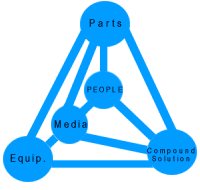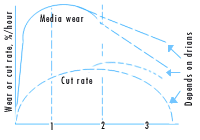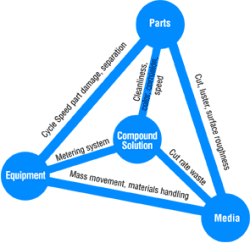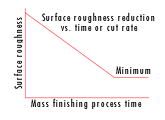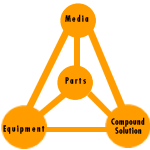Understanding Vibratory Finishing: Part 1 of 4: Media
The relationship of media, compound solutions, equipment and parts in successful vibratory finishing. how to improve your troubleshooting...
#basics
When a problem develops in vibratory finishing, how do you solve it? Where do you begin? And why? These articles in PRODUCTS FINISHING will look at the critical interdependence of four key elements in solving your problems in vibratory finishing.
Tetrahedron. Four elements are significant in vibratory finishing: the parts, the media, the compound solution and the equipment. These four link to form an interdependent network portrayed in Fig. I as the "Tetrahedron of Interdependence." This awesome mouthful merely means that these elements depend on each other to such an extent that if one fails the process fails.
Featured Content
The tetrahedron also shows that the "glue" holding it together can weaken or break causing minor or major failures in the process. By studying the tetrahedron and the "glue" which binds it, we will learn how these interact. From this understanding you should be able to troubleshoot more effectively.
The series of articles will discuss media first, the compound solution next, then equipment and finally, most important of all, the parts.
Media
In Fig. 1, "media" is one of the three legs holding up or supporting the parts. In one sense this is true. In another sense (Fig. 2) the media is supported by the other three "legs." The point here is that they support each other. Like the equipment, compound solution and parts, media is critical to the success of the process. Because our purpose is to improve troubleshooting abilities, the many types of media will not be discussed. Instead, we will consider change and what causes it; how media changes affect other portions of the process; and how changes in these other factors affect the media.
This discussion will be in five sections: media functions; effect of media on parts; relationships between media and the compound, solution; media and equipment; and effects of people on media. Note that three of these five are the "glue" holding media to other elements in the tetrahedron.
Functions. The "chips" or "stones" in vibratory finishing are ailed "media." While there are many variations, from aggressive grades capable of removing large quantities of metal from parts in short cycles to media which cannot cut at all, each type has the following functions:
- Separates and cushions parts.
- Contacts critical edges and surfaces.
- Provides proper degree of cut or luster.
- Resists lodging in parts.
- Permits separation from parts.
Separates and cushions parts. Parts are mixed with media in a random distribution. The ratio of parts to media helps to control the amount of contact the parts have with themselves. If insufficient media is between the parts, parts will collide, often with great vigor. Media cushions this impact so that irreparable damage to the parts does not occur. This effect is not important in vibratory finishing of forgings, but it is a key consideration in preplate finishing of die castings Calculation of media-to-parts ratio is easily done, and should always be considered when finishing fragile surfaces.
Contacts critical edges and surfaces. Obviously, for media to work it must make contact with the parts. Certain shapes can lead to a false sense of security in this regard however. Plastic cones, for example, are very popular, and available in a variety of sizes. That pointer end can touch all areas of a part. But if the cone is relatively large and not a blend of sizes, the pointed end does not really do much work. The areas where the media does the most work are where the base diameter, has access to the part surface. Why? The answer is that a piece of media works on a surface in a position of stability.
Prove it for yourself. Pour cones on a surface. None will have the pointed end down. Most will be on their sides and some will have bases down.
In the bases-down position, contact pressure is very low and little or no work will be done. This means most of the work done is done while they are on their sides.
Now, where is the center of gravity of a cone? It is quite near the base. And with the base rim design popular in the mass finishing industry, it is even lower. When the shape is on its side, a much greater force is exerted on the big diameter and this means little pressure is on the small end. Cones with heights greater than their diameters are even worse.
Provides proper degree of cut or luster. Abrasive media will cut. More and bigger abrasive will result in more cut. Non-abrasive media can only produce luster.
Resists lodging in parts. If media sticks in the parts, someone must remove it. If this is difficult, cost of removal can exceed cost of the process. To prevent lodging, manufacturers of media produce a great variety of shapes and sizes. Often several shapes and/or sizes are required to handle the variety of parts to be finished.
It is worth noting that two or more small machines are usually better than one big one if various parts need be processed. Good process notes are a great help, too, so the wheel need not be reinvented every time the part comes back for processing. Know what media you used and how much per load.
Permits separation from parts. Any time you mix parts with media, the two must eventually be separated. The efficiency of this operation depends on the equipment available, but also on the shape and sizes of media and parts. More about this later.
Abrasive media functions
Abrasive media has distinct functions in addition to the above. Abrasive media has the following characteristics:
- Releases abrasive slowly into the system.
- Has ability to cut edges and surfaces.
- Can deburr or radius edges.
- Can develop required surface smoothness.
- Will last as long as possible.
Proper particle size. Media is similar to a grinding wheel. As it cuts, abrasive grain is lost, the wheel gets smaller, and by so doing, fresh abrasive is exposed. Media also wears and exposes fresh grains. But unlike the wheel or belt, media wear against other media. It is designed to. By so doing, media keeps clean and ready to cut with fresh abrasive.
Rate of wear of mass finishing media varies with the media and intended use. Media designed for rotary barrels, for example, will wear out much too fast in higher-energy equipment such as the vibratory types. And media designed for vibratory use will wear out too fast in barrels and other centrifugal equipment.
Abrasive particle size controls depth of cut. Bigger particles cut deeper and give rougher surfaces.
The hardness of the abrasive should be significantly greater than the material being cut. Silica works fine on soft metals, for example, but has marginal use for hard steel.
Cuts edges and surfaces. Abrasive media "cuts." When they cut edges, they remove burrs. When it cuts surfaces, it changes the surface contour, taking off the high spots and refining the rest with that media's characteristic scratch pattern.
Deburrs or radiuses edges. The Burr, Edge and Surface Conditioning Technology Division of the Society of Manufacturing Engineers has defined a "burr" as "an undesirable projection of material that results from a cutting, forming, blanking or shearing process."
Removing the burr may or may not be your objective. You may only have to reduce the burr size or eliminate the edge sharpness so that users or assembly people won't cut themselves. Once you have removed the undesirable portion, however, you have "deburred" the part.
Putting a radius on an edge is doing considerably more work on that edge than simply deburring it. It requires more metal removal. Radiussing generally takes more time and uses faster-cutting, larger media.
Develops required surface smoothness. Surface smoothness can be measured by a stylus or capacitive sensing probe type of instrument. Units generally used read in microinches or micrometers, AA, or arithmetic average. Development of good, smooth, low-microinch surfaces is easily done, but care must be exercised. Fig. 3 shows the relationship between surface roughness and time in a mass finishing process. It also characterizes media. The slope or steepness of the curve represents the cut rate or surface roughness reduction vs. time. This slope varies with the type of media, as seen in Fig. 4. Note that the fast-cutting products give rougher surfaces at their minimum capability.
Lasts as long as possible. To the user, the ideal media will last forever. It can happen with nonabrasive media such as steel, but not with abrasive media. Heavy-cutting grades wear faster.
Non-abrasive media
Non-abrasive media performs as follows:
1. Peens or pounds edges and surfaces.
2. Deburrs edges lightly.
3. Brightens surfaces.
4. Has little or no wear or loss.
Peens or pounds edges and surfaces. Since it cannot cut and since energy is imparted to it, nonabrasive media can only pound surfaces and edges. Its action is much like tiny ball-peen hammers. No scratch pattern can develop, since nothing is cutting the surfaces. Instead, a series of small, uniform dents is imparted to the surface of the work, and then more dents on those dents.
Brightens surfaces. The series of small dents is followed by more and more pounding until the surface gets brighter. This can occur quickly with steel media on malleable metals, but may be slow to develop or never develop on hard steels. Work-hardenable alloys create problems with brightening.
Deburrs edges lightly. Again, because no cut occurs, edges are pounded. This constant impact dulls edges and can remove sharpness.
Has little or no wear or loss. Media wears primarily by rubbing against other pieces of media until abrasive grains fall out or are cut away. With no abrasive, cut stops and so does wear.
One must always remember that media cannot change its functions as the parts change. It cannot do more today than last week because the burr is bigger.
Effect of media on parts
In Fig. 1 the "glue" holding media-to-parts includes "cut, luster and surface roughness. " The degree of abrasiveness determines the amount of cut and the resultant surface roughness. Luster or reflectivity requires a lack of abrasive influence on the surfaces.
From all of the foregoing, it is evident that media is the key to success. What if the cut rate of the media suddenly changes? What could cause this?
It could be that the latest batch of media is defective. Today, however, from the probability standpoint, this is not likely. When and if an error in manufacturing of media occurs, it is usually of such a small magnitude that the typical user would not be able to detect it. If there is such a problem it's usually a defect in the integrity of the bond holding the abrasive grain in place. If so, the wear will be higher than normal, not less. Cut rate will be greater, not less, and the change may not be detectable.
The manufacturer of media could use the wrong abrasive in his product. This type of defect would normally be caught by the producer before shipment. But if not, deeper and faster cutting and rougher surfaces would indicate that too-large abrasive was used. A slower cut and brighter finish would indicate too fine an abrasive.
Color changes, imperfect pieces, holes and other defects could be a problem in critical applications where, for example, deformed pieces lodge in parts. If this happens, alert your supplier and send him samples.
In all likelihood, media does the same job on a routine basis, day in and day out. If a different grade of media is used and the results change, that is not the fault of the media. Different media, different results. But that is a problem caused by the operator, not by the media.
Relationships with the compound solution. Have you noticed that we refer to the compound "solution" rather than just the compound? For a good reason. The process doesn't "see" the compound. It only "sees" the solution! So big deal. Why the distinction?
If you agree that the same compound will act in very different ways in waters of different hardness, your question is answered. Other materials dissolved in water also have an effect, such as dissolved iron, sulfur dioxide, oil and entrained particles. The solution is the important thing, not just the compound.
Now, what could the compound possibly do to affect the media? All it does is make suds, right? Wrong. From the standpoint of probability alone, the compound solution is the most likely source of problems. This is the least understood and, as a result, the most frequently abused portion of the entire process.
The solution can change in many ways. A different compound may be tried. The concentration may be changed. The water may vary. Many of these slowly cause problems.
In Fig. 1, the media-compound solution bond includes "cut rate" and "waste. " Can the compound solution control cut rate? Let's see.
Fig. 5 is a pictorial view of clean and dirty processes. The dirty process is characterized by a coating of sludge around everything in the machine. The clean process has no thin film of sludge. The same illustration shows the movement of the tub wall as the "initial amplitude. " If the wall is coated with sludge, energy transfer to the piece of media next to it won't be too efficient. And that's exactly what happens. The energy is damped in each successive transfer, until, at the interface of the part and the media, a significant reduction of energy has occurred. Cut rate has dropped. It must. In the clean system, on the other hand, almost complete transfer of energy occurs.
This effect is one of the significant differences between vibratory finishing and other mass finishing techniques, such as rotary barrel or centrifugal barrel techniques. These latter two are essentially positive-displacement methods; the mass is elevated and gravity makes it slide down. The energy source is not the container wall, but falling from an elevation. These positive-displacement methods therefore are less sensitive to sludge buildup.
Fig. 6 shows the effect of solution flow rate on media wear and metal-removal rates. It supports the contention of Fig. 5. At zero flow, cut and wear stop. No media can get to the parts. Everything is covered with gunk. No cut. And no wear. Nothing.
As the flow rate of solution is increased, cut and wear increase as well. At flow rates below about one gal of solution per cu ft of media per hr of operation, generally the media and parts are still dirty. This is the area of operation recommended by those who advocate the "mud system." The logic here is that since you've paid for the abrasive, keep it in the machine and use it. The error in this theory is that the ratio of media wear to media cut is high--much higher than when the same media is used with higher compound flow rates.
At higher flow rates, the process is more efficient. The most common range is between one and 2.25 gal per cu ft per hr. This translates to about 20 to 45 gal of solution per hr of operation for a 20-cu-ft machine.
In this flow range, parts emerge clean! We'll talk more about cleaning in a later article, but notice that cleaning doesn't cost a lot. So why accept dirty parts? In this range too, the media mass cuts its fastest. It has to. Time cycles also must be the shortest in this range.
At the highest flow rates in Fig. 6 note that both cut and wear are reduced. This effect is caused by "flooding" of the machine. Too much solution is going in for the drain system to remove efficiently. Machine design, we should note, often includes too few drains for efficient solution removal. Equipment is less expensive to build that way.
Some "burnishing" compounds are designed to impart a great deal of lubricity to the mass. These can reduce or even stop cut of media. They tend to "glaze" the media. When dry, glazed media has a glassy surface. It's polished. Some media is designed to be very sensitive to these compounds and can be used to "cut" with a good deburring compound and then "color" or burnish with the soapy type compounds.
Concentration
Measure concentration in pct or in oz/gal or in g/liter. But measure it. And control it. Why? This is the most difficult question to answer clearly, but it is vital to success in the process.
Compounds are the most competitive product in the mass finishing industry. Many are easy to make with simple equipment and literally hundreds of manufacturers make such products. Unfortunately, most of these aren't worth much because their creators don't know much about the demands put on them. But since there are so many products and competition is so great, manufacturers must keep the content of the active materials rather low. Put in too much chemical and the manufacturer is no longer competitive.
Additionally, these products are designed to be used in very low concentrations--on the order of one-half to one fluid oz/gal (four to eight ml/liter). That represents a dilution of from 256-to-1 to 128-to-1. That's thin. And efficient.
Therefore, if we try to run our process at one-fourth fluid oz/gal, the amount of active materials in solution to take care of water hardness, clean and inhibit corrosion is just not enough.
Each of these functions requires a minimum threshold amount in the final solution to be effective. If this threshold amount is not reached, the effect is not there. So don't turn down the compound feed without turning down the water, too. It's better to run the vibratory process on too low a flow rate of solution than on too low a concentration of compound in the water!
Problems with the compound solution take time to show up. The sludge builds slowly. Media glazing is a slow process. By the time the effect is noticed, the cause may be forgotten. Hence the problem. And this brings us to Rule 1: Keep It Clean. It pays. The money and time you save will be your own.
The other portion of the "glue" holding media to the compound solution is "waste." This is the output from the machine, or effluent--the combined spent solution and residue from the media. While many large industrial plants dilute this with other plant waste, smaller ones or those with little other liquid waste cannot. Special treatments may be required for some wastes; and in some areas where regulatory agencies are strict. More treatment to eliminate pollution can be expected as EPA rules are enforced.
Relationships between media and equipment. The equipment must process the parts and separate them from the media later. It controls the action of the mass during the process.
To control action of the mass, vibratory equipment has adjustments, such as speed, amplitude and weight position.
Speed is easily monitored by using a tachometer supplied with the equipment, or by employing the manual types of meters, using either a strobe light or vibrating reed. Higher speeds produce more rapid cut, faster media wear, shorter bearing life and sometimes louder noise.
Amplitude is easily measured by a device called an "AmpliCheck," ©Minnesota Mining and Manufacturing Co., 1967, as shown in Fig. 7. When subjected to vibration even with the oval patterns set up in the round vibratory equipment, the circles will form the same pattern. Big circles form a kind of blurred figure 8 with a "cat eye" between top and bottom. Read to the left, or toward the smaller circles, until the "cat eye" just disappears. The diameter of the inside of that circle is the amplitude of the machine. These devices are calibrated in either 32nds of an inch or in millimeters (one mm = 0.0394 inch).
Amplitude usually is dependent on the amount of eccentric weight on a vibratory machine. Round vibrators also have adjustable weight positions. These machines have two eccentric weights, one on each end of their vertical shaft. The amount of weight on each and the relative position are the variables.
Speed, amplitude and weight settings should be recorded on all process sheets which define the process. Only in this way can we return to conditions that were successful on a previous occasion.
Always run at the lowest possible machine amplitude and speed. The media is more efficient at these settings.
Materials handling is an important factor to be considered in selecting a piece of mass finishing equipment. The media must be handled during each separation cycle, every day, all year. Much time can be lost if inefficient equipment is used. If, for example, we wasted only five minutes separating time on each one-hour cycle, we would waste an entire month each year!
Separation time is very important. People make the decision on the equipment to buy, don't they? So where do people fit in?
People
Some of the ways that people influence the mass finishing process have been shown already. There are others.
For example, a person must keep the vibratory machine filled with media. He must decide when and how much to add. Is the machine kept full? If not, low levels reduce the media-to-parts ratio and greater part-on-part contact occurs.
How does the operator load parts? All in one place at one time? Same effect or worse. Part-on-part damage here can be so bad that the rest of the cycle can't eliminate the damage. Don't blame it on poor cutting media. It's a people problem.
When did you last change suppliers? And why? To purchase a cheaper product from a supplier who offers no technical service? Then who do you call to get out of trouble?
People are vital to the success of the mass finishing process. Good, knowledgeable suppliers are an excellent source of information. They can prevent problems by pointing out potential sources of trouble.
PRODUCTS FINISHING and other technical publications have information the alert user will clip and save.
The Burr, Edge and Surface Conditioning Technology Division of SME has put on numerous conferences, published many papers and two important books1,2 on the subject of burrs, deburring and how to do it. Take advantage of them. That's what they're for. You!
Fig. 8 puts people in their rightful place--right in the middle of the tetrahedron. They exercise control. They make decisions. They create change. People can therefore strengthen the process structure and reinforce it, or they can destroy the critical "glue" or change the nature of one of the key elements. They can make or break the process.
Media has an amazing influence on the vibratory finishing process. But, for the media to work, the solution system must behave, the equipment must perform, the parts must be uniform and, above all, people must not make waves too high for the process to get through. Which brings us to Rule 2: If the process works right, leave it alone! The process does the same thing Monday morning and Thursday afternoon. And right on through coffee breaks. Count on it.
RELATED CONTENT
-
Alkaline Cleaning Guide
Gregg Sanko, Senior Chemist, Oakite Products, Inc. provides an overview of the alkaline cleaning process.
-
Aluminum Surface Finishing Corrosion Causes and Troubleshooting
In this paper, a review of several process solutions, examining coolants, solvent cleaning, alkaline clean/etch and deoxidizing/desmutting, listing intended and unintended chemical reactions along with possible mechanisms that would favor corrosion formation.
-
Nickel Electroplating
Applications, plating solutions, brighteners, good operating practices and troubleshooting.


